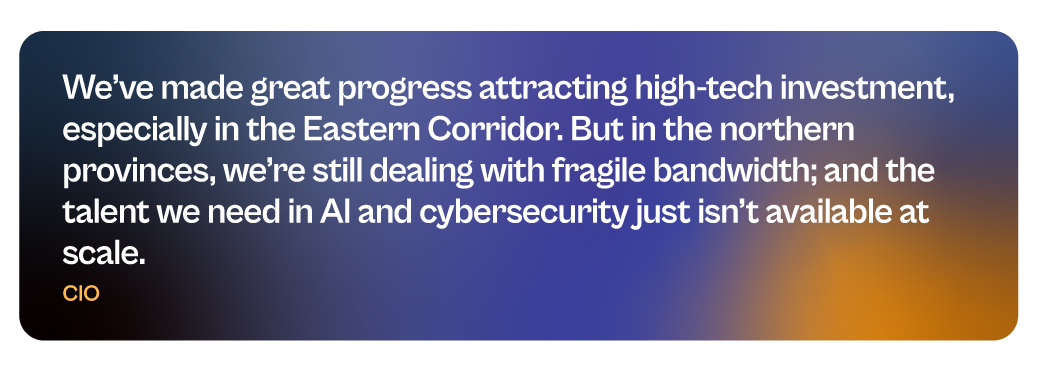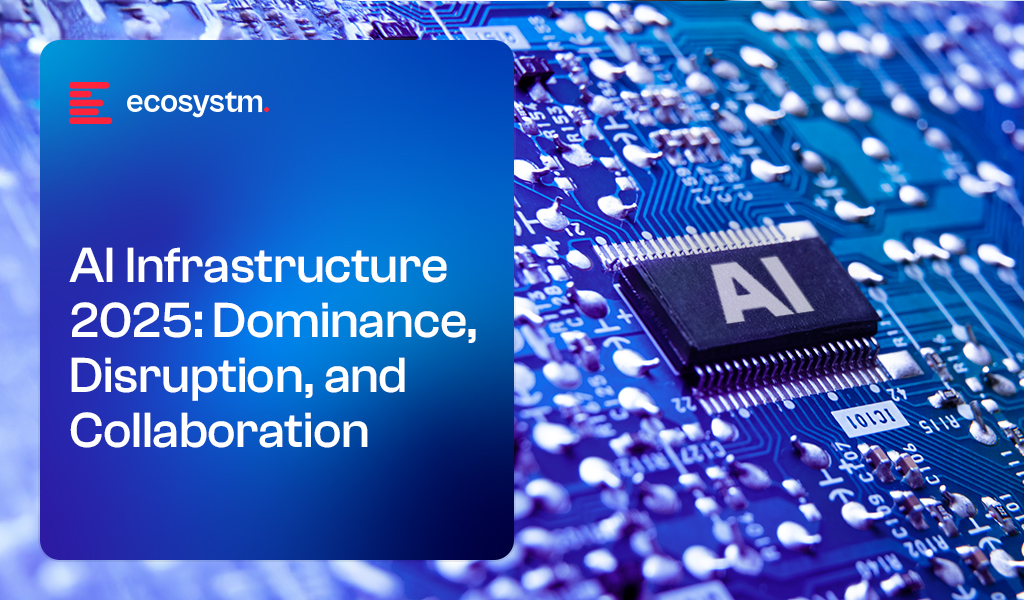Thailand’s digital transformation has shifted from an ambitious policy agenda to a national necessity. As the country accelerates its Thailand 4.0 strategy, digital platforms are becoming central to boosting competitiveness, enhancing public services, and building economic resilience. From logistics and healthcare to finance and manufacturing, digital tools now underpin how Thailand moves, heals, pays, and grows.
Recent reforms, including the National AI Strategy, Smart City Masterplan, and National Digital ID framework, have been paired with efforts to strengthen digital infrastructure nationwide. Yet challenges remain: integrating platforms across government, closing the generational digital divide, and safeguarding vulnerable users in a rapidly evolving fintech and gig economy.
Through multiple roundtables and stakeholder dialogues, Ecosystm has uncovered five core themes that highlight both the momentum and the friction points in Thailand’s digital journey.
Theme 1: Bridging the Regional Divide
Thailand’s digital transformation is accelerating in urban centres like Bangkok, Chonburi, and Rayong, but rural and low-income regions, especially in the North and Deep South, continue to lag. Gaps in connectivity, digital skills, and modern technical education are limiting access to online learning, mobile banking, and digital public services, while also holding back the growth of tech-driven industries.
Initiatives like Net Pracharat have brought broadband to over 75,000 villages, and new investments in regional data centres and telecom infrastructure show promise. Still, last-mile gaps and fragile networks persist, particularly in conflict-affected or underserved areas. Even where fibre is available, unstable connections often block meaningful digital adoption.
At the same time, Thailand’s push into future-focused industries such as EVs, semiconductors, AI, and smart logistics, is straining its talent pipeline. The Eastern Economic Corridor (EEC) is attracting major investment, but the demand for skilled workers in data science, cybersecurity, and industrial AI far exceeds supply. Many regional technical education systems have not kept pace, widening the skills gap.
To ensure inclusive growth, Thailand needs to pair infrastructure investment with targeted reskilling and education reform. Programs like the Digital Skill Development Academy and revamped TVET initiatives are important first steps; but broader progress will require stronger industry-academia partnerships, faster certification pathways, and universal access to digital learning.

Theme 2: Unifying Government Services for a Seamless Citizen Journey
From PromptPay-linked welfare payments and Mor Prom for health services, to the rollout of the NDID (National Digital ID), Thailand has made considerable progress in digitalising public services. Citizens can now access more services online than ever before.
However, many of these systems still operate in silos, with duplicated citizen data, separate logins, and limited backend integration between agencies. Ministries and local governments often lack the interoperability standards and cloud infrastructure needed to provide seamless, real-time services.
The next phase of government digitalisation must focus on platform-level integration, supported by secure data sharing frameworks, API-first design, and privacy-by-default policies. The goal is to move from digitising transactions to building a citizen-centric, connected state, where services are proactive, mobile-friendly, and unified across domains.

Theme 3: Strengthening Public Trust Through Proactive Cybersecurity
With the rise of digital government, cloud adoption, and cashless ecosystems, Thailand’s attack surface is rapidly expanding. High-profile breaches in healthcare, telecom, and finance have triggered growing public concern around data misuse, fraud, and infrastructure vulnerabilities.
The government has enacted the Cybersecurity Act (2019) and PDPA (2022), and agencies like the National Cybersecurity Agency (NCSA) are stepping up threat monitoring. But cybersecurity maturity across sectors remains uneven. Many SMEs, regional hospitals, and even provincial government systems operate with limited threat intelligence and minimal incident response protocols.
Cybersecurity must now move from compliance to strategic resilience. This includes building sector-specific response plans, launching cyber drills in critical infrastructure, and scaling cyber talent development across the country. Trust in digital services will depend not just on what’s offered, but on how securely it’s delivered.

Theme 4: Scaling Trust Through Local Language, Visibility, and Human Oversight
AI systems in Thailand are increasingly interfacing with the public, from chatbots and digital assistants to automated approvals and diagnostics. However, public trust in these systems remains fragile, particularly when users cannot understand how decisions are made or get help when things go wrong.. Language barriers and unclear design only add to the uncertainty.
Many AI tools are built in English-first environments, with limited Thai-language optimisation or cultural context. In rural areas or among older populations, this can create friction and resistance, even when the underlying system works well. Without transparency, user control, or recourse, AI tools risk being seen as alienating rather than empowering.
To build public confidence, AI deployments must prioritise explainability, Thai-language usability, and built-in pathways for human support. This includes interface localisation, clear model intent statements, and fallback mechanisms. Trust will not be built through performance alone, it must be earned through transparency, accessibility, and responsiveness.

Theme 5: Embedding Governance to Sustain Smart Urban Growth
Thailand has made significant headway in its smart city development agenda, with over 30 provinces participating in the national Smart City program. Flagship initiatives in Phuket, Chiang Mai, Khon Kaen, and parts of the EEC have introduced smart traffic systems, e-governance tools, environmental monitoring, and digital tourism platforms.
However, many smart city projects are still pilots, driven by local champions, reliant on short-term grants, and lacking long-term governance structures. Fragmented data, unclear stakeholder roles, and limited collaboration between cities continue to slow scale and national replication.
The Smart City Office under DEPA is working to address these challenges by developing standard frameworks, urban data platforms, and public-private investment models. To maintain momentum, Thailand will need to embed smart city governance in multi-year digital urban strategies, establish shared infrastructure foundations, and invest in capacity-building for local leaders.
For smart cities to succeed, they must move beyond tech demonstrations and deliver real, lasting improvements in liveability, safety, and economic opportunity.

Sustaining Momentum in a Connected Nation
Thailand’s digital future won’t be defined by policy or technology alone; but by how effectively the country aligns infrastructure, skills, services, and trust at scale. The foundations are already being built in classrooms, city halls, data centres, and boardrooms. The real opportunity lies in weaving these efforts into a cohesive, resilient digital fabric. Lasting impact will come not just from momentum, but from turning vision into everyday value for people, communities, and businesses alike.

Barely weeks into 2025, the Consumer Electronics Show (CES) announced a wave of AI-powered innovations – from Nvidia’s latest RTX 50-series graphics chip with AI-powered rendering to Halliday’s futuristic augmented reality smart glasses. AI has firmly emerged from the “fringe” technology to become the foundation of industry transformation. According to MIT, 95% of businesses are already using AI in some capacity, and more than half are aiming for full-scale integration by 2026.
But as AI adoption increases, the real challenge isn’t just about developing smarter models – it’s about whether the underlying infrastructure can keep up.
The AI-Driven Cloud: Strategic Growth
Cloud providers are at the heart of the AI revolution, but in 2025, it is not just about raw computing power anymore. It’s about smarter, more strategic expansion.
Microsoft is expanding its AI infrastructure footprint beyond traditional tech hubs, investing USD 300M in South Africa to build AI-ready data centres in an emerging market. Similarly, AWS is doubling down on another emerging market with an investment of USD 8B to develop next-generation cloud infrastructure in Maharashtra, India.
This focus on AI is not limited to the top hyperscalers; Oracle, for instance, is seeing rapid cloud growth, with 15% revenue growth expected in 2026 and 20% in 2027. This growth is driven by deep AI integration and investments in semiconductor technology. Oracle is also a key player in OpenAI and SoftBank’s Stargate AI initiative, showcasing its commitment to AI innovation.
Emerging players and disruptors are also making their mark. For instance, CoreWeave, a former crypto mining company, has pivoted to AI cloud services. They recently secured a USD 12B contract with OpenAI to provide computing power for training and running AI models over the next five years.
The signs are clear – the demand for AI is reshaping the cloud industry faster than anyone expected.
Strategic Investments In Data Centres Powering Growth
Enterprises are increasingly investing in AI-optimised data centres, driven by the need to reduce reliance on traditional data centres, lower latency, achieve cost savings, and gain better control over data.
Reliance Industries is set to build the world’s largest AI data centre in Jamnagar, India, with a 3-gigawatt capacity. This ambitious project aims to accelerate AI adoption by reducing inferencing costs and enabling large-scale AI workloads through its ‘Jio Brain’ platform. Similarly, in the US, a group of banks has committed USD 2B to fund a 100-acre AI data centre in Utah, underscoring the financial sector’s confidence in AI’s future and the increasing demand for high-performance computing infrastructure.
These large-scale investments are part of a broader trend – AI is becoming a key driver of economic and industrial transformation. As AI adoption accelerates, the need for advanced data centres capable of handling vast computational workloads is growing. The enterprise sector’s support for AI infrastructure highlights AI’s pivotal role in shaping digital economies and driving long-term growth.
AI Hardware Reimagined: Beyond the GPU
While cloud providers are racing to scale up, semiconductor companies are rethinking AI hardware from the ground up – and they are adapting fast.
Nvidia is no longer just focused on cloud GPUs – it is now working directly with enterprises to deploy H200-powered private AI clusters. AMD’s MI300X chips are being integrated into financial services for high-frequency trading and fraud detection, offering a more energy-efficient alternative to traditional AI hardware.
Another major trend is chiplet architectures, where AI models run across multiple smaller chips instead of a single, power-hungry processor. Meta’s latest AI accelerator and Google’s custom TPU designs are early adopters of this modular approach, making AI computing more scalable and cost-effective.
The AI hardware race is no longer just about bigger chips – it’s about smarter, more efficient designs that optimise performance while keeping energy costs in check.
Collaborative AI: Sharing The Infrastructure Burden
As AI infrastructure investments increase, so do costs. Training and deploying LLMs requires billions in high-performance chips, cloud storage, and data centres. To manage these costs, companies are increasingly teaming up to share infrastructure and expertise.
SoftBank and OpenAI formed a joint venture in Japan to accelerate AI adoption across enterprises. Meanwhile, Telstra and Accenture are partnering on a global scale to pool their AI infrastructure resources, ensuring businesses have access to scalable AI solutions.
In financial services, Palantir and TWG Global have joined forces to deploy AI models for risk assessment, fraud detection, and customer automation – leveraging shared infrastructure to reduce costs and increase efficiency.
And with tech giants spending over USD 315 billion on AI infrastructure this year alone – plus OpenAI’s USD 500 billion commitment – the need for collaboration will only grow.
These joint ventures are more than just cost-sharing arrangements; they are strategic plays to accelerate AI adoption while managing the massive infrastructure bill.
The AI Infrastructure Power Shift
The AI infrastructure race in 2025 isn’t just about bigger investments or faster chips – it’s about reshaping the tech landscape. Leaders aren’t just building AI infrastructure; they’re determining who controls AI’s future. Cloud providers are shaping where and how AI is deployed, while semiconductor companies focus on energy efficiency and sustainability. Joint ventures highlight that AI is too big for any single player.
But rapid growth comes with challenges: Will smaller enterprises be locked out? Can regulations keep pace? As investments concentrate among a few, how will competition and innovation evolve?
One thing is clear: Those who control AI infrastructure today will shape tomorrow’s AI-driven economy.




